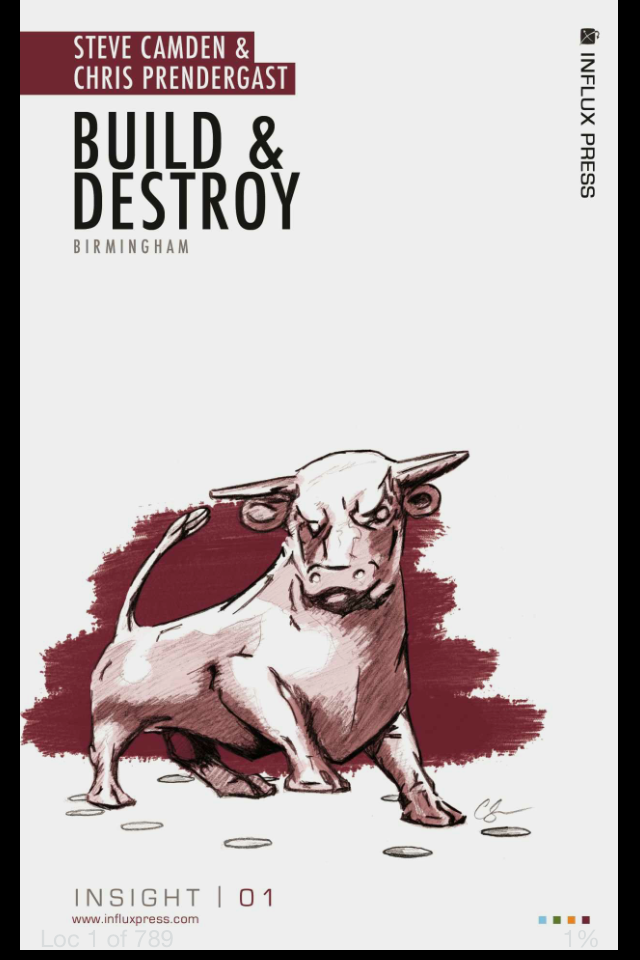Built, destroyed and rebuilt - Build and Destroy: Birmingham
Build & Destroy
This fascinating short book is part of a series of essays from Influx Press exploring the idea of place. The only thing missing from the title of this book is 'rebuild' which would sum up perfectly Birmingham's evolution through building, destroying and then rebuilding and also the authors own experience understanding the city of their exile.
Chris Prendergast presents the first essay, The Bullring Effect as a critique on the now self titled centre of the city and it's transformation - 'we are so city'. Now an exile at Keele University he provides a more academic consideration of the changes brought about by the new Bullring to the identity of the city, it's role in public space and the social effect of such regeneration on the people of Birmingham.
A photo of the shopping centre map of the Bullring featuring the Aardman model of the city with Bullring under the identity of: We are So City.
The first essay reminded me of a book I read ten years ago, written almost a year after the opening of the Bullring in 2003, titled Remaking Birmingham, which included a chapter by Joe Holyoak, a Birmingham architect and urban designer. In Chapter 1 of the book titled Street, Subway and Mall: Spatial Politics in the Bull Ring, Holyoak looks at the development of proposals to redevelop the 1960s shopping centre in the 1980s, the clash of public and private and privatisation of public space and the discord between shopping centre and markets.
The democracy of the street allows an urban society to be what it is, and to show what it is, for better or worse (Holyoak, 2004, p.21).
Prendergast notes the architectural historian Pevsner who was prescient in his comment on the rebuilding of the city in the 1960s acquiring a form 'which it will keep for many years' and one where 'the roads came first and the buildings had to be fitted in'.
Prendergast comments on the regeneration model that has often used Bilboa and the Guggenheim as a precursor to the Bullring and Selfridges, Birmingham's own Guggenheim avant garde architecture, but with the question of how deep a change to the city's image.
"Visit for the art, stay for the food and shopping. The Bullring is different. It targets the shopping tourist who comes from outlying suburbs, neighbouring towns and even alternative cities for a slice of 'prestige'" (Prendergast, 2014)
Prendergast also considers the new Bullring which allows the outside in with the glazed roof and indoor seats to rest weary legs but still fulfils the legacy of the 1960s subterranean approach to car above pedestrian as you exit New Street station along covered routes never needing to pass through the outside. This has been exacerbated temporarily while the engineering project of rebuilding a station while keeping it open creates tunnels between the Bullring and the fresh air of New Street. With the regenerated Pallasades shopping centre becoming Grand Central and an unbroken undercover route from New Street Station to John Lewis and through to the Bullring do people come for the shopping and in reverse of the above quote stay for the art and food?
My photos of the markets and Bullring.
Steve Camden, also known under the stage name Polarbear, presents the second essay, through his gift of storytelling, the experience of Birmingham and how it imbues his experiences through change in his life and experiences in his exiled home of London. This funny essay captures the oft ignored Brummie experience socially and how you can take the person out of Birmingham but you can never take the Brummie out of the person.
In Prendergast's essay he notes the 1998 documentary Heart By-Pass with critic Jonathan Meades noting that while the name of the city is known the people and the city itself are not. Camden responds to this not through academic or defined rebuttal but the power and heartfelt Brummie spirit that is imbued by growing up in the city. The character isn't so easy to label as the mixture of characteristics not so easy to define.
It's a quality that sits somewhere between eclecticism and incoherance, stubborness and ambition, self-awareness and self-sacrifice (Prendergast, 2014)
Camden's stories on growing up and the impact that your experiences, views of the world and family play on shaping your identity was fascinating and while there isn't a single defining explanation of being imbued with a single Birmingham feature the collective whole gave rise to the feeling that there is something quite defining about Birmingham.
There was something about Birmingham that made it feel like everyone living there felt like they were inside some kind of fortress. A fortress who's walls were only as strong as the no nonsense resolve and pride of it's people (Camden, 2014).
As a Brumophile, I loved reading about the city I call home and I found the essays a good consideration and critique on how I have perceived the value of the Bullring in changing the city's perceptions. The writing is engaging and in the first essay you are left asking questions on the real legacy of the city's transformation through shopping and to what cost. The second essay was a funny engaging read on how the experience of place shapes your experiences and understanding on the world and how there is a question in those who help to shape younger minds about experiences that how will they in turn shape ideas and forgot or change ideas and beliefs.
As Camden notes at the end, if people ask you one thing about yourself you can say 'I'm from Birmingham'.
That's the beauty of the essays, the ever asking 'What for' of Birmingham and the city that never stops building and destroying.
The book is available as an e-book from Amazon here: http://www.amazon.co.uk/Build-Destroy-Birmingham-Steven-Camden-ebook/dp/B00HURDU94






Comments